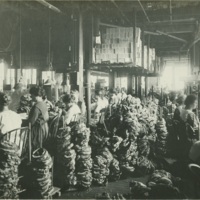Localization of the Shoe Industry
“Little, A.E. and Company. Shoe manufacturer. Stitching room.” Courtesy of Lynn Public Library via Digital Commonwealth.
With the domestic demand for shoes down after World War I and the shoe-exporting business on the decline, Massachusetts, the hub of the American shoemaking industry, saw a forty-two percent drop in statewide employment between January and December of 1920. Factory shutdowns were declared so abruptly at some factories that many workers thought they had simply been locked out.
The stronghold of unions in Massachusetts' shoe industry kept the remaining workers’ wages high. This, combined with the localization of shoemaking in other states, would ultimately spell disaster for Massachusetts' factories.
As the population in western states grew, many of Massachusetts' shoemaking companies opened branch factories and distributing offices afar, leasing machines to other states. Missouri was one such state with a growing shoe industry -- as Massachusetts’ own was shrinking -- and it produced nearly a tenth of America’s shoes. Missouri’s lower cost of living, combined with its lack of unions to advocate for higher factory wages, enabled companies to hire cheaper labor and increase revenue. The labor cost of one pair of shoes in 1919 stood at seventy-seven cents in Massachusetts, compared to a mere fifty-two cents in Missouri.
Without the national demand for Massachusetts’ shoe output, revenue dropped while local wages remained high, causing the state’s once burgeoning industry to plummet.




